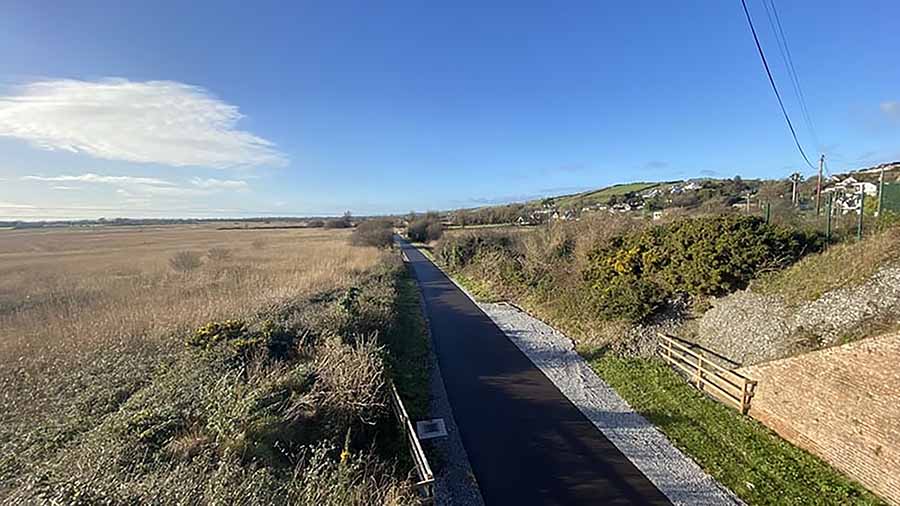
By Eoghan Corry
The Greenway movement in Ireland has developed, not as you might expect, from customer demand, but from various local authorities looking at us decrepit assets they add that they could turn into cycle ways and walk ways without confronting the daunting issue that be devils infrastructure, projects in Ireland, private property and rights of access.
Mayo was a happy choice to begin the project, because of an enthusiastic local minister, Michael Ring, with great powers of persuasion. After an exhaustive process (one landowner wanted a county council contract to deliver gravel, in return, before he would sign a right of way agreement), they managed to create a few kilometers of separated walkway and cycleway.
It was praised and celebrated in the media, good news for Irish tourism at a time when numbers were plummeting during the Global Financial Recession. There was a problem that was not mentioned in the press release. The cyclists who would be persuaded to participate in this route where landed on a busy narrow road in Newport.
Two more greenways were discussed in the immediate aftermath. One was in Waterford, the other was in what is called South Kerry, but is actually on an old railway line along the north coast of the Iveragh peninsula.
Waterford commenced, continued at pace and was finished before the negotiations with the Kerry landowners had even gone halfway through the process.
Limerick’s greenway came with difficulties of its own. There was a largely intact railway line, some opposition from local landowners, but the problem was not enough cycle tourists really wanted to go to Limerick in the first place.
The tow paths of the Grand and the Royal canals, at the Barrow, were also in varying states of decrepitude along their lengths. Activating them without investment, which is what the department hoped, proved trickier than expected.
Most of the other greenways which came onto the planning process, each with business plans, underestimated cost estimates, grossly overestimated revenue estimates, and rosy business plans expressed in very suspiciously similar language about bringing communities together and generating tourism in parts where no tourists had ever gone before, landed in a sludge pile on the desks of the various departments who might have a contribution to make, either real or imagined.
Declaring the obvious was unpopular, that separated cycleway and walkway in Ireland was so far behind the rest of Europe that they could not even see. the hill they had passed, never mind the rear lights of the bicycles of Germany, France and Spain.
This was regarded as unpatriotic and curmudgeonly, and led to unseemly exchanges in occasional media debates. But the catch-up is unlikely without a reboot in legislation and funding. France (six times the size of Ireland) has an estimated 6,000km of off-road cycleway, Germany (four times the size of Ireland) has 2,859km. Ireland has 400km and many of our off-road, or free cycling tracks, as they are known, are not always off-road.
And in the years since, the progress has been glacial, as the distance we trail our competitors growing in multiples.
- Great Western Greenway: Original of the species opened in 2011 in County Mayo, this is the longest off-road cycling and walking trail in Ireland, stretching 42 kilometers from Westport to Achill Island. The route takes you through picturesque countryside, coastal paths, and charming villages, offering breathtaking vistas of Clew Bay and the Nephin Beg mountains.
- Waterford Greenway: Hugely successful since its opening in 2017, this 46-kilometer greenway follows the former railway line from Waterford City to Dungarvan. It passes through stunning coastal scenery, lush farmland, and even the atmospheric Ballyvoyle Tunnel. Along the way, you’ll have opportunities to discover historical landmarks, enjoy local food, and appreciate magnificent views of the coastline.
- Great Southern Trail: through County Limerick and County Kerry, this greenway is built on the old Limerick to Tralee railway line. The trail extends for about 40 kilometers and offers a tranquil countryside experience. As you explore, you’ll encounter, and historical sites, all while enjoying the beauty of rural Ireland.
- Royal Canal Greenway: Opened in March 2021 and stretching 130 kilometers across the midlands of Ireland, the Royal Canal Greenway runs from Dublin to Longford and offers a mix of picturesque landscapes, historic sites, and interesting landmarks. The route passes through quaint villages, rolling countryside, and peaceful canalside settings, providing a peaceful and scenic journey.
- Great Southern Greenway Limerick: Opened in October 2022, this greenway covers 39 kilometers, running from Rathkeale to the edge of Limerick City. It follows the old Limerick to Tralee railway line, offering peaceful countryside vistas, charming bridges, viaducts and village stops, with a spur to Barnagh viewpoint. via Barnagh tunnel. Along the way, you can discover ancient ruins and enjoy the tranquility of rural Ireland.
- Boyne Greenway: Located in County Meath and push started with a cycleway in 2014, the Boyne Greenway is under development and will stretch for 50 kilometers alongside the River Boyne. This greenway provides a mix of natural beauty, historical landmarks, and cultural sites. You can explore the Boyne Valley, visit iconic historical sites such as the UNESCO World Heritage Site of Brú na Bóinne, and take in stunning views of the river and surrounding landscape.
- Grand Canal Greenway: A still incomplete greenway, largely consisting of grassy towpaths, it will stretch for approximately 117 kilometers, running from Adamstown in County Dublin to Shannon Harbour in County Offaly. Kilbeggan stretch opened in February 2022.



